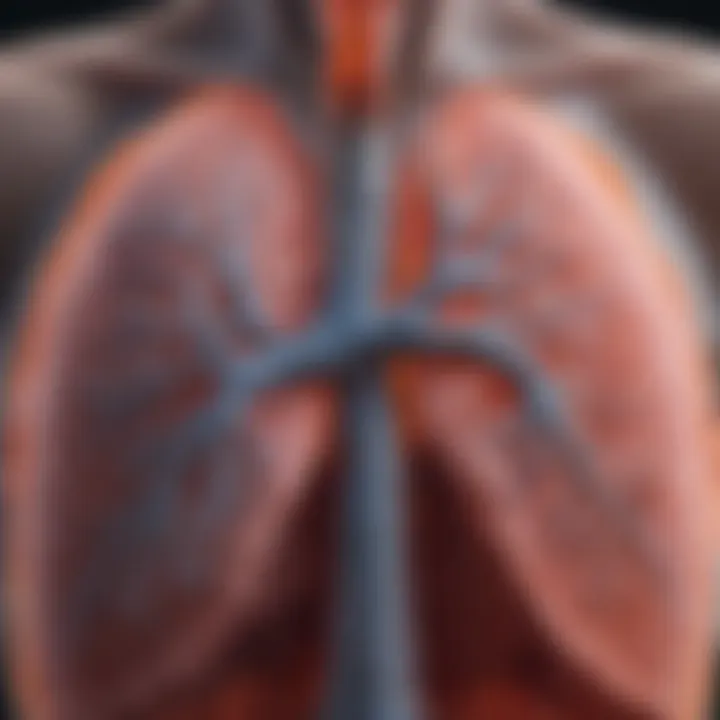The Relationship Between Asthma and Smoking: An In-depth Analysis


Intro
Asthma, a chronic respiratory condition characterized by airway inflammation and hyperreactivity, affects millions around the globe. A notable risk factor that often enters the discussion is smoking. The relationship between smoking and asthma can be both direct and indirect, with tobacco smoke contributing to the onset of asthma in some individuals while exacerbating it in others.
Exploring this relationship involves looking at how smoking affects respiratory health generally and understanding the specific mechanisms at play for those already diagnosed with asthma. Current research sheds light on these complex interactions, emphasizing the importance of addressing this public health concern.
A comprehensive understanding of asthma and its interactions with smoking is crucial for multiple stakeholders, from healthcare professionals to public health advocates. Evaluating existing literature, this analysis aims to provide insights into effective management and prevention strategies, enhancing the overall understanding of this critical topic.
Understanding Asthma
Asthma is a critical area of study within respiratory health, particularly in the context of smoking. Understanding asthma lays a foundation for examining how smoking might affect individuals already diagnosed with this condition. This section presents a comprehensive overview of asthma, defining it, exploring its various types, and identifying its symptoms and diagnosis, which are essential for contextualizing the relationship between smoking and asthma.
Defining Asthma
Asthma is a chronic inflammatory disease that affects the airways in the lungs. It leads to recurrent episodes of wheezing, breathlessness, chest tightness, and coughing, particularly at night or in the early morning. The significance of this definition cannot be overstated, as it helps to identify asthma not simply as a singular event but as a long-term condition that can be influenced by numerous internal and external factors, including smoking.
Types of Asthma
Different types of asthma exist, each with its unique characteristics and triggers. Understanding these types enhances awareness about how factors like smoking may exacerbate symptoms in specific populations.
Allergic Asthma
Allergic asthma is triggered by allergens such as pollen, dust mites, or animal dander. This type is prevalent among asthma patients and represents a significant contributor to overall asthma cases. The ability to pinpoint allergy-related triggers is critical; it allows patients to manage their condition more effectively. The main advantage of identifying allergic asthma is that it often responds well to targeted treatments, thus improving quality of life.
Non-Allergic Asthma
Unlike allergic asthma, non-allergic asthma does not stem from external allergens. It can be triggered by factors like exercise, stress, or respiratory infections. This type signifies the broader range of asthma's manifestations and highlights the importance of personalized management strategies. While the variance in triggers can complicate treatment, understanding non-allergic asthma is vital to ensuring that individuals do not overlook their triggers, which can lead to mismanagement and increased symptoms.
Exercise-Induced Asthma
Exercise-induced asthma manifests when physical activity leads to asthma symptoms, typically due to bronchial constriction. This type is particularly relevant for athletes or individuals who are physically active. Recognizing this condition is crucial; it enables patients to engage in physical activity while effectively managing their symptoms. The unique feature here is the timing and circumstances under which symptoms occur, necessitating that individuals develop strategies to mitigate the impact of exercise on their asthma.
Symptoms and Diagnosis
Symptoms of asthma can vary widely among individuals. Common indicators include recurring cough, shortness of breath, wheezing, and chest tightness. Accurate diagnosis often relies on a combination of medical history, physical examination, and specific tests such as spirometry. Early identification and diagnosis are significant especially for individuals who smoke, as they may already be subject to lung irritation, complicating asthma management. Prompt recognition of symptoms can lead to better health outcomes and improved response to treatments, an important note in understanding the intricacies of asthma and its potential relationship with smoking.
The Role of Smoking in Respiratory Health
Understanding the role of smoking in respiratory health is critical in comprehending how it relates to asthma. Smoking is not merely a behavioral choice; it involves inhalation of toxic substances that can lead to significant respiratory ailments. The importance of this topic cannot be overstated, especially when considering the intricate relationship between smoking and asthma. Many individuals with asthma find that smoking exacerbates their condition, leading to a decline in their overall lung function and well-being.
Chemical Composition of Tobacco Smoke
Tobacco smoke contains more than 7,000 chemicals, many of which are harmful. Among these, nicotine, tar, carbon monoxide, and formaldehyde are especially notable.
- Nicotine: Primarily known for its addictive properties, nicotine can also contribute to airway inflammation.
- Tar: This substance coats the lungs and can inhibit normal respiratory function.
- Carbon Monoxide: This gas binds with hemoglobin, reducing oxygen delivery to tissues.
- Formaldehyde: A known irritant that can provoke allergic reactions and worsen asthma symptoms.
These components wreak havoc on the respiratory system, leading to chronic inflammation and structural changes in the airways. This makes smoking not just a personal choice but a public health concern.


Impact of Smoking on Lung Function
The impact of smoking on lung function is profound and well-documented. Studies show that smoking can lead to decreased lung capacity, making it harder for individuals to breathe. Smoking can also impair cilia function in the airways, which play a crucial role in clearing mucus and debris. This impairment increases the risk of respiratory infections, which may trigger asthma attacks. Research indicates that even short-term smoking can start to degrade lung function in asthmatics.
"Individuals who smoke are at a considerably higher risk for acute asthma exacerbations, and their long-term respiratory outcomes are often poor."
"Individuals who smoke are at a considerably higher risk for acute asthma exacerbations, and their long-term respiratory outcomes are often poor."
The combination of these factors leads to increased hospital visits and a reduced quality of life for affected individuals.
Risk Factors Associated with Smoking
Several risk factors are associated with smoking, particularly concerning respiratory health. Understanding these factors helps to underline the dangers of smoking for asthmatics.
- Age of Initiation: Starting smoking at a young age multiplies the risks associated with respiratory diseases.
- Cumulative Exposure: The longer one smokes, the greater the damage to lung tissue.
- Co-existing Respiratory Conditions: Individuals with existing conditions, such as chronic obstructive pulmonary disease (COPD), experience amplified effects from smoking.
- Environmental Exposure: Exposure to secondhand smoke poses risks similar to those of direct smoking, particularly in children and non-smokers living with smokers.
Recognizing these risks plays a crucial role in public health strategies designed to mitigate the effects of smoking and improve respiratory health outcomes.
Is Smoking a Cause of Asthma?
Understanding the connection between smoking and asthma is essential for multiple reasons. Asthma, a chronic respiratory condition, can be influenced by a variety of factors, including environmental triggers and lifestyle choices. Smoking is particularly significant, as it may not only exacerbate existing conditions but potentially contribute to the onset of asthma.
This section delves into the nuances of whether smoking acts as a direct cause of asthma. By examining research, mechanisms, and the crucial distinction between causation and correlation, we can better understand the effects of smoking on respiratory health. Such insights are invaluable for health professionals, educators, and patients alike as they navigate the complexities of asthma management and prevention strategies.
Research Overview
Current literature provides a diverse array of findings related to smoking and asthma. Numerous studies demonstrate that smoking may lead to the development of asthma, particularly during the formative years. Research conducted by the American Academy of Allergy, Asthma & Immunology indicates that children exposed to cigarette smoke are more prone to developing asthma than their peers. Furthermore, lifelong smokers face increased risks of respiratory disease, which includes asthma.
A comprehensive review published in the Journal of Allergy and Clinical Immunology suggests that the relationship between smoking and asthma is multifaceted. While some studies indicate that smoking leads to more severe asthma symptoms, others show that asthma might be aggravated by smoking in those already diagnosed. This inconsistency highlights the necessity for further investigation into specific populations and smoking habits.
Mechanisms of Action
The mechanisms through which smoking affects asthma are complex. Tobacco smoke contains a cocktail of harmful chemicals that can irritate the airways and impair lung function. Here are some key factors:
- Inflammatory Response: Tobacco smoke triggers an inflammatory response in the lungs. This inflammation can lead to airway hyperreactivity, a hallmark characteristic of asthma.
- Mucus Production: Smoking has been shown to increase mucus production, creating blockages and contributing to difficulty in breathing. Excess mucus can exacerbate asthma symptoms.
- Airway Remodeling: Long-term exposure to smoke may lead to changes in airway structure, known as remodeling, which can worsen asthma severity over time.
These mechanisms highlight how smoking can not only initiate asthmatic symptoms but also worsen existing conditions.
Causation vs Correlation
The question of whether smoking directly causes asthma or simply correlates with it is critical. While the functional damage caused by smoking aligns with asthma pathology, many researchers advocate for the distinct differentiation between causation and correlation.
- Causation implies that smoking directly initiates asthma development.
- Correlation suggests that smokers may have greater asthma prevalence due to compounded risk factors, such as genetic predispositions or environmental exposures.
Some studies present evidence supporting smoking as a causal factor. However, other studies emphasize the role of genetics and environmental influences. This may explain why not all smokers develop asthma, while some non-smokers do.
In summary, while the data tilts towards a causal relationship, ongoing research is essential to clarify this multifactorial issue. By differentiating between causation and correlation, we can better inform public health initiatives and individual management strategies for asthma in the context of smoking.
Smoking and Existing Asthma Conditions


The interaction between smoking and existing asthma conditions is a vital area of focus in this analysis. Understanding how smoking influences asthma can guide therapeutic approaches and enable better health outcomes for individuals who already suffer from asthma. Smoking is not merely an isolated risk factor; it compounds the complexities of managing asthma. When patients with asthma smoke, they are likely to experience increased symptoms, exacerbation of their condition, and complications that may arise from the interplay of these health issues.
Effects of Smoking on Asthma Symptoms
Smoking has a well-documented impact on asthma symptoms. For individuals with asthma, exposure to tobacco smoke can lead to various effects:
- Increased Frequency of Symptoms: Smokers with asthma report experiencing more frequent wheezing, coughing, and shortness of breath compared to non-smokers.
- Reduced Response to Medication: Research indicates that smoking can diminish the efficacy of asthma medications, making it harder for patients to manage their symptoms effectively.
- Increased Severity of Attacks: Smokers are at a greater risk of severe asthma attacks which can lead to hospitalizations or more serious health issues.
- Prolonged Recovery Times: After an asthma attack, smokers tend to experience longer recovery periods compared to their non-smoking counterparts.
The effects of smoking on asthma symptoms highlight its detrimental influence, underscoring the need for targeted intervention strategies for smokers suffering from asthma.
Complications Arising from Co-existing Conditions
Co-existing conditions present another layer of complexity in managing asthma for smokers. These conditions, often linked to the consequences of smoking, include respiratory infections, chronic bronchitis, and emphysema. The relationship is significant for the following reasons:
- Increased Inflammation: Smoking contributes to chronic inflammation in the airways, worsening asthma symptoms and complicating the management of co-existing respiratory conditions.
- Higher Risk for Pneumonia: Smokers with asthma have an elevated risk for pneumonia, which can lead to severe complications if not addressed promptly.
- Diminished Lung Function: Combined impact of smoking and asthma can lead to a more rapid decline in lung function over time.
- Potential for Other Diseases: Smokers might develop other diseases, such as cardiovascular problems, that can further complicate asthma management and overall wellness.
Thus, understanding the interplay between smoking and existing asthma is crucial for health professionals. Effective strategies must incorporate smoking cessation as a part of holistic asthma management to improve patient outcomes and quality of life.
Statistical Evidence and Research Findings
Understanding the statistical evidence and research findings related to asthma and smoking is crucial in distinguishing the couples effects and their broader implications for public health. Reliable data not only highlights the high-risk demographics but also aids in directing prevention and intervention strategies. The statistics provide insight into the prevalence and severity of asthma in smokers versus non-smokers. Analyzing these patterns enables healthcare providers and policymakers to implement more effective public health initiatives aimed at reducing smoking, especially among vulnerable populations.
Prevalence of Asthma in Smokers vs Non-Smokers
Research indicates a marked difference in asthma prevalence between smokers and non-smokers. Studies have shown that individuals who smoke are more likely to experience persistent asthma symptoms compared to those who do not smoke. The following points summarize these findings:
- Increased Incidence: Smokers have a higher tendency to develop asthma, and existing asthma conditions often worsen due to smoking.
- Worse Outcomes: The severity of asthma attacks is generally higher in smokers than in non-smokers, leading to increased hospitalizations and medical costs.
- Demographics: Certain groups, such as young adults and women, are disproportionately affected by asthma related to smoking.
The implications of these findings extend to both personal health and healthcare systems. Understanding who is more at risk helps in tailoring educational programs about the consequences of smoking and asthma management. Additionally, this data informs healthcare policy to prioritize targeted interventions for at-risk groups.
Longitudinal Studies and Their Implications
Longitudinal studies provide valuable insights concerning the relationship between smoking and asthma over time. These studies track the same individuals, allowing researchers to understand how smoking behaviors influence the development or exacerbation of asthma conditions.
Key Findings from Longitudinal Studies:
- Chronic Damage: Continuous exposure to tobacco has been linked to chronic respiratory issues, including asthma degradation.
- Age Factor: Younger individuals who smoke are more likely to develop asthma at an earlier age compared to non-smokers, suggesting a cumulative effect.
- Progression of Disease: In subjects with pre-existing asthma, smoking accelerates the progression, resulting in a higher risk of severe symptoms or complications.
The significance of these studies cannot be overstated; they underline the urgent need for smoking cessation programs as part of asthma management strategies. As the population ages, understanding these long-term effects becomes ever more critical for crafting effective public health campaigns.
Public Health Implications
Understanding the public health implications of the relationship between smoking and asthma is crucial for advancing respiratory health initiatives and shaping effective policies. The interplay between these two factors significantly affects the overall health outcomes of populations. Smoking exacerbates asthma symptoms, leading to increased morbidity and frequent hospitalizations. This burden on healthcare systems necessitates comprehensive public health strategies that focus on education, prevention, and cessation programs.
Smoking Cessation Programs
Implementing smoking cessation programs is essential for asthma management and improved public health. Research shows that when smokers with asthma quit, their symptoms often reduce, and lung function can improve over time. Cigarette smoking contributes to inflammation in the lungs, worsening asthma control. A well-structured cessation program includes behavioral therapies and pharmacotherapy options like nicotine replacement therapy. Providing support through counseling can address psychological dependencies associated with smoking.


Smoking cessation campaigns must target not only the general population but also those with existing asthma. Educational materials that discuss the negative effects of smoking on their condition could empower patients to make informed decisions about their health.
Preventative Measures for Asthma Control
Preventative measures for asthma control play an integral role in mitigating the adverse effects of smoking. These measures can reduce the frequency and severity of asthma attacks, thereby enhancing the quality of life for patients. Key strategies include:
- Identifying Triggers: It is vital to understand and avoid environmental and lifestyle triggers that may worsen asthma, including smoke exposure.
- Regular Health Check-ups: Routine monitoring by healthcare providers can help track asthma control and any progression.
- Proper Medication Use: Adherence to prescribed medication, such as inhalers and steroids, is critical in managing asthma effectively.
- Educating Patients and Families: Raising awareness about asthma and its management helps create an environment conducive to asthma control.
"Effective asthma control can significantly reduce hospitalizations and enhance patients’ everyday lives."
"Effective asthma control can significantly reduce hospitalizations and enhance patients’ everyday lives."
Incorporating these preventative measures into public health campaigns engages communities and improves overall health outcomes for individuals living with asthma. By addressing smoking as a primary concern, public health efforts can contribute to a healthier future for those affected.
Personal Management Strategies for Asthma Patients
The management of asthma is a critical factor in ensuring that patients maintain their quality of life. Personal management strategies equip individuals with the knowledge and tools necessary to navigate daily challenges associated with asthma, particularly when compounded by smoking. These strategies are essential in minimizing symptoms, reducing the risk of exacerbations, and fostering overall well-being.
Creating a tailored approach will significantly benefit asthma patients. It helps them understand their condition better and empowers them to take an active role in their health management. This is particularly important when we consider the detrimental impact of smoking on respiratory health.
Developing an Asthma Action Plan
An asthma action plan is a written document that outlines individualized strategies for managing asthma symptoms. It plays a significant role in promoting better control over the condition. This plan typically includes information about medications, symptoms to monitor, and steps to take during an asthma attack.
- Medication Management: Patients should understand their prescribed medications, which may include long-term control medicines and quick-relief inhalers. Clearly indicating when and how to use these medications is crucial.
- Symptom Monitoring: The plan should delineate specific symptoms, such as wheezing or shortness of breath, that may indicate worsening asthma. Recognizing these early signs is essential for timely intervention.
- Response Actions: It is beneficial to outline the immediate steps to take based on symptom severity. Including emergency contact information and what to do in a crisis can provide peace of mind and prompt action when needed.
"An effective asthma action plan can reduce emergency visits and improve quality of life."
"An effective asthma action plan can reduce emergency visits and improve quality of life."
Monitoring and Avoiding Triggers
Identifying and avoiding asthma triggers is vital for patients. Triggers can vary from person to person, but commonly include allergens, respiratory infections, physical activity, and even tobacco smoke.
- Environmental Control: Patients should be encouraged to minimize exposure to known triggers in their surroundings. This can involve regular cleaning, using air purifiers, or ensuring that living areas are free from dust and smoke.
- Lifestyle Adjustments: Making lifestyle changes can significantly reduce the frequency of asthma attacks. For example, quitting smoking can lead to improved lung function and overall respiratory health. Moreover, avoiding secondhand smoke is crucial for those living with asthma.
- Regular Check-Ups: Frequent consultations with healthcare practitioners allow for timely adjustments to treatment plans based on individual triggers and symptoms.
Epilogue
The topic of smoking and its relationship with asthma warrants significant attention due to the substantial implications for public health and individual wellness. Understanding how smoking interacts with asthma can lead to important strategies for prevention and management.
Summarizing the Evidence
A clear body of research illustrates that smoking exacerbates asthma symptoms, leading to higher rates of hospitalizations and decreased overall lung function. Studies show a notable link between cigarette smoke exposure, either as a smoker or secondhand, and increased asthma severity. Many affected individuals experience more frequent and severe symptoms in the presence of tobacco smoke.
Research consistently highlights the differences between smokers and non-smokers with asthma, demonstrating that smokers tend to have worse outcomes. Moreover, data from longitudinal studies suggest a higher prevalence of asthma among smokers, which may indicate a cyclical relationship where asthma symptoms motivate smoking cessation efforts, yet the damage inflicted by smoke complicates management strategies.
"The interaction of smoking and asthma reveals a multifaceted relationship requiring multifactorial solutions."
"The interaction of smoking and asthma reveals a multifaceted relationship requiring multifactorial solutions."
Future Directions in Research
Future research endeavors should explore the underlying biological mechanisms linking smoking to asthma development and exacerbation. A more nuanced understanding of how specific compounds in tobacco smoke affect immune response and airway inflammation can inform effective treatment options.
Furthermore, looking into the role of genetics could better elucidate why some individuals with asthma are more vulnerable to the effects of smoking than others. Additional studies might also focus on behavioral interventions that merge smoking cessation with asthma management, aiming to provide holistic care for affected individuals. With a comprehensive approach, it is possible to enhance patient outcomes and ultimately reduce the burden of asthma linked to smoking.



